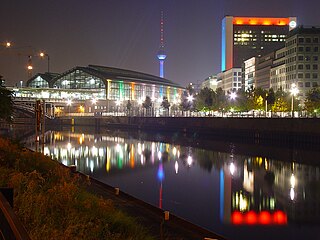
The Berlin S-Bahn is a rapid transit railway system in and around Berlin, the capital city of Germany. It has been in operation under this name since December 1930, having been previously called the special tariff area Berliner Stadt-, Ring- und Vorortbahnen. It complements the Berlin U-Bahn and is the link to many outer-Berlin areas, such as Berlin Brandenburg Airport. As such, the Berlin S-Bahn blends elements of a commuter rail service and a rapid transit system.

U1 is a line on the Berlin U-Bahn, which is 8.8 kilometres (5.5 mi) long and has 13 stations. Its traditional line designation was BII. It runs east–west and its eastern terminus is Warschauer Straße S-Bahn station where it connects to the Schlesische Bahn. From there it runs through Kreuzberg via Gleisdreieck and Wittenbergplatz on to the Kurfürstendamm.

U2 is a line of the Berlin U-Bahn. The U2 line starts at Pankow S-Bahn station, runs through the eastern city centre (Alexanderplatz) to Potsdamer Platz, the western city centre and finally to the Ruhleben terminal station.
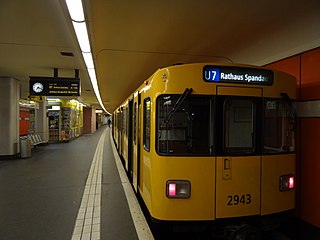
The U7 is a rail line on the Berlin U-Bahn. It runs completely underground for a length of 31.8 kilometres (19.8 mi) through 40 stations and connects Spandau, via Neukölln, to Gropiusstadt and Rudow. The U7 was originally the south-eastern branch of the Nord-Süd-Bahn (U6) that ran between the branching point at Belle-Alliance-Straße (Mehringdamm) and Grenzallee; however, in the 1960s, this stretch was separated from the rest of the line and extended at each end to form a new line.
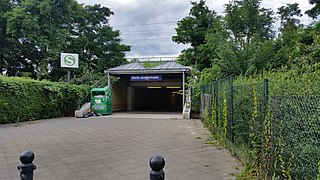
Berlin Jungfernheide is a railway station located at Charlottenburg-Nord, in the Charlottenburg-Wilmersdorf district of Berlin, served by the S-Bahn lines S41 and S42, the U-Bahn line U7 and Regional-Express trains of the Deutsche Bahn. Its name literally translates into "maidens' heathland"; it was named after the Jungfernheide, a former large forest in the proximity of this station.

Berlin Hauptbahnhof is the main railway station in Berlin, Germany. It came into full operation two days after a ceremonial opening on 26 May 2006. It is located on the site of the historic Lehrter Bahnhof, and on the Berlin S-Bahn suburban railway. The station is owned by DB InfraGO, a subsidiary of Deutsche Bahn AG, and is classified as a Category 1 station, one of 21 in Germany and four in Berlin, the others being Berlin Gesundbrunnen, Berlin Südkreuz and Berlin Ostbahnhof.

Köln Hauptbahnhof is the central railway station of Cologne, Germany. The station is an important local, national and international transport hub, with many ICE, Eurostar and Intercity trains calling there, as well as regional Regional-Express, RegionalBahn and local S-Bahn trains. EuroNight and Nightjet night services also call at the station. It has frequent connections to Frankfurt by way of the Cologne–Frankfurt high-speed rail line, which starts in southern Cologne. On an average day, about 280,000 travellers frequent the station, making it the fifth busiest station in Germany.

Stuttgart Hauptbahnhof is the primary railway station in the city of Stuttgart, the state capital of Baden-Württemberg, in southwestern Germany. It is the largest regional and long-distance railway station in Stuttgart, the main node of the Stuttgart S-Bahn network, and, together with the station at Charlottenplatz, it is the main node of the Stuttgart Stadtbahn.

Berlin Jannowitzbrücke is a station in the Mitte district of Berlin. It is served by the S-Bahn lines S3, S5, S7, and S9 and the U-Bahn line U8. It is located next to the Jannowitz Bridge (Jannowitzbrücke) and is a public transport interchange. South of the station is Brückenstraße and north of it are Holzmarkstrasse and Alexanderstraße. The station also serves as a stop for various private excursion and sightseeing boats, among others, those of the Stern und Kreisschiffahrt and Reederei Riedel companies.
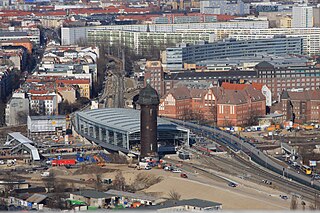
Berlin Ostkreuz station is a station on the Berlin S-Bahn suburban railway and the busiest interchange station in Berlin. It is in the former East Berlin district of Friedrichshain, now part of the borough of Friedrichshain-Kreuzberg. A smaller part of the station is in Rummelsburg, part of the borough of Lichtenberg. The station is a Turmbahnhof with the Berlin–Frankfurt (Oder) railway and the Prussian Eastern Railway on the lower level and the Berlin Ringbahn on the upper level. It is used by a total of around 235,000 passengers every day on eight lines, entering or leaving.
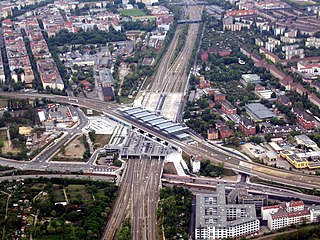
Berlin Südkreuz station is a railway station in the German capital Berlin. The station was originally opened in 1898 and is an interchange station. The Berlin Ringbahn line of the Berlin S-Bahn metro railway is situated on the upper level and connects to the east and west, whilst the Anhalter Bahn and Dresdner Bahn intercity railway routes reach the station on the lower, north-south level. The station was extensively rebuilt between the late 1990s and 2006, and was renamed Berlin Südkreuz on 28 May 2006.

The Berlin Stadtbahn is the historic east-west elevated railway of Berlin. It runs from Friedrichshain in the east to Charlottenburg in the west, connecting several of the most major sights of the German capital. The line is protected cultural heritage since 1995. It is often defined more simply as the slightly longer route between Ostkreuz and Westkreuz, although this is not technically correct.

Berlin Alexanderplatz is a German railway station in the Mitte district of Berlin's city centre. It is one of the busiest transport hubs in the Berlin area. The station takes its name from its location on Alexanderplatz, near the Fernsehturm and the World Clock.

Berlin-Charlottenburg is a railway station in the Charlottenburg district of Berlin. The station is located on the Stadtbahn line, served by the S3, S5, S7, and S9 lines of the Berlin S-Bahn, as well as by Regional-Express and Regionalbahn trains operated by Deutsche Bahn. The U-Bahn station Wilmersdorfer Straße (U7) can be reached via short footpath.

Berlin-Spandau station is a Deutsche Bahn station in the Berlin district of Spandau on the south-western edge of the old town of Spandau. The railway junction station is one of the 80 stations classified by Deutsche Bahn as a category 2 station. It has the longest train shed in Germany.

Westend is a station in the Charlottenburg district of Berlin. It is located on the Ringbahn circle line, served by the S-Bahn lines S41, S42 and S46. It is named after the Westend locality, which is immediately adjacent to the station grounds. The entire station area was opened—as Charlottenburg-Westend—in several stages from 15 November 1877, but it has since been reduced to an S-Bahn platform and a pair of long-distance tracks. The station was closed temporarily in 1980 because of the S-Bahn strike. A platform on the Ringbahn was reopened in 1993 for S-Bahn traffic. The restoration of all of the station infrastructure is not planned.

Berlin Tiergarten is a railway station on the Berlin Stadtbahn line in the Tiergarten district of Berlin. It lies between the stations of Zoologischer Garten and Bellevue on the Straße des 17. Juni in the Hansaviertel locality of the Mitte borough. It opened in 1885 and is served by the S-Bahn lines S3, S5, S7 and S9 and located very close to the Großer Tiergarten park. The station is part of the Stadtbahn viaduct and has heritage listing.

Messe Nord/ICC (Witzleben) is a station in the Charlottenburg district of Berlin. It is located on the Ringbahn circle line, served by S-Bahn lines S41/S42 and S46. It is linked to the Kaiserdamm U-Bahn station on line U2 via a short footpath.

Berlin Westkreuz is a station in the Charlottenburg district of Berlin. It is served by the S-Bahn lines S3, S41, S42, S46, S5, S7 and S9 and so represents a major interchange point on the Berlin S-Bahn network. It lies at the opposite end of the Stadtbahn to Ostkreuz and is one of the four main stations on the Ringbahn.

The North–South S-Bahn Tunnel is the central section of the North–South transversal Berlin S-Bahn connection crossing the city centre. It is not to be confused with the Tunnel Nord-Süd-Fernbahn, the central tunnel part of the North–South main line used by intercity and regional trains. The S-Bahn North–South line encompasses the route from Bornholmer Straße and Gesundbrunnen via Friedrichstraße and Anhalter Bahnhof to Papestraße and Schöneberg.
























